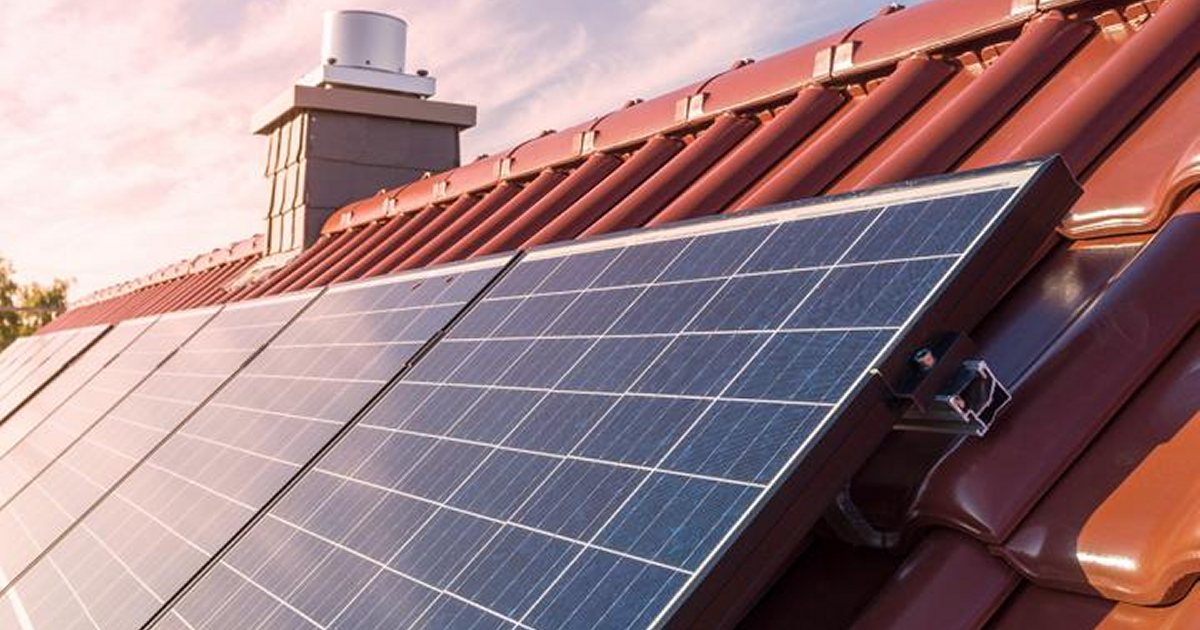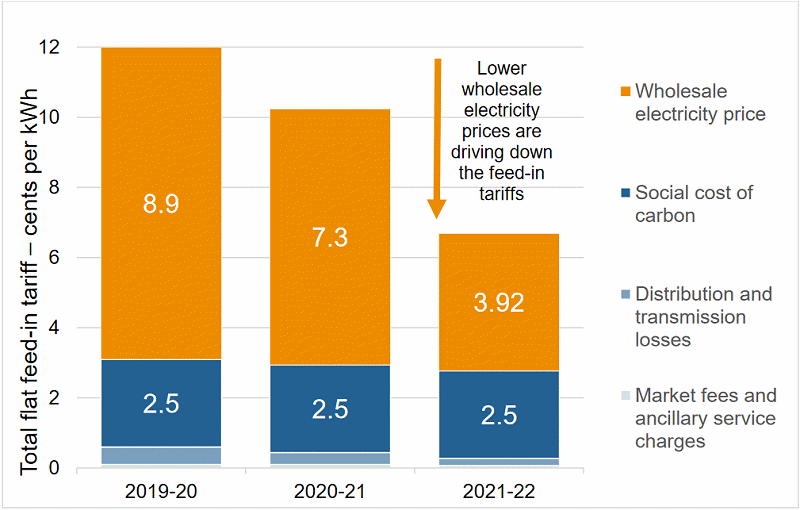
While Victoria’s minimum feed in tariff rates will reduce from the beginning of July this year, solar panels will remain a solid investment.
Renewable energy is pushing down wholesale electricity costs, which is great news. But this also puts downward pressure on solar feed in tariff (FiT) rates.
In November last year, Victoria’s Essential Services Commission released its draft decision on minimum feed-in tariff rates from 1 July 2021. At that point, it was considering a minimum single rate for 2021–22 of 7.1 cents per kilowatt-hour, down from the current 10.2 cents.
Last week, the Commission released its final decision on minimum feed-in tariff rates – and the cuts were even deeper than in the draft.
| Period | Weekday | Weekend | 2020/21 c/kWh |
2021/22 c/kWh |
| All times | All day | All day | 10.2c | 6.7c |
| Off peak | 10pm – 7am | 10pm – 7am | 9.1c | 6.7c |
| Shoulder | 7am – 3pm 9pm -10pm |
7am – 10pm | 9.8c | 6.1c |
| Peak | 3pm – 9pm | n/a | 12.5c | 10.9c |
The single rate (6.7c) is the rate most Victorians will be paid. Off peak, shoulder and peak rates are part of a “time varying” option some electricity retailers may offer.
It’s important to note that these are the minimum rates – retailers can choose to offer more, and some do.
Feed-In Tariff Components
The components that make up the FiT in Victoria are:
- Wholesale electricity price
- Avoiding the social cost of carbon
- Avoided distribution and transmission losses
- Avoided market fees and ancillary service charges
You can see from the following how much of an impact forecast wholesale electricity prices had in the ESC’s decision.
Wholesale electricity prices account for approximately 60-70 per cent of the minimum feed-in tariffs, but only 30 per cent of a retail electricity bill. You can learn more about why solar feed in tariffs are significantly lower than electricity usage tariffs here.
Will Solar Still Be Worth It In Victoria?
Yes, definitely.
While stating the days of high rates paid for surplus solar electricity exported to the mains grid appear to be over, ESC pricing director Marcus Crudden noted the enduring value of solar and battery storage is avoiding paying retail charges for mains supplied electricity.
For example, an electricity retailer may offer a 12c/kWh feed-in tariff, but charge 24c per kilowatt-hour for mains grid electricity consumed by a solar household. Maximising solar energy self-consumption really pays off.
“To avoid paying the higher retail rates it is in solar customers’ interests to use as much of the electricity they generate from their solar panels as possible,” said Mr. Crudden. “During the day when the sun is shining, solar customers should run their washing machine, dishwasher, water heater and other energy intensive appliances.”
So, how does a feed-in tariff of 6.7c affect payback on a solar system?
SQ’s trusty solar calculator used with its default settings aside from adjusting the FiT value and also taking into account Victoria’s solar panel rebate indicates a good quality 6.6kW solar power system installed in Melbourne will achieve simple payback in around 4 years, 3 months.
It is possible feed in tariffs will increase in the future, but for relatively short periods. If coal-fired clunker Yallourn Power Station was to close early, that could result in some upward pressure on wholesale electricity prices for a while, but the general trend will for be cheaper wholesale electricity. However, feed in tariffs won’t disappear altogether any time soon – or ever.
The Essential Services Commission’s full decision on minimum solar feed-in tariffs to apply from 1 July 2021 can be viewed here and further information on Victoria’s feed in tariff found here.
Across the border in New South Wales, IPART has also signalled it may reduce the non-mandatory benchmark FiT range for 2021/22.


 RSS - Posts
RSS - Posts



I would kike someone who is better at thermodynamics than I am to tell me how the increase in heat input for the planet due to increased carbon compares with the increased heat input caused by the increase in entropy caused by all the processes going on in the world.
Thanks
Cheers
Graham
All human activity, less the effects of net greenhouse gas emissions, is about 0.01% of the earth’s total energy budget and averages out to about 0.034 watts per square meter. That’s about one 6,000th the output of a space heater. Industrial civilization’s greenhouse gas emissions result in about 2 watts of warming per square meter. That’s around one thousandth of the output of a space heater. So civilization’s greenhouse gas emissions are warming the earth around the same extent as running 10 space heaters per hectare over the entire surface of the planet.
Ah Victoria…with one hand they giveth and with the other they taketh away.
Like all governments,they tell lies. We have solar on our house, 20x310W panels, 2 occupants, only wash once per week, have gas cooktop, electric oven(only use it once per week), solar hotwater. Was getting 15cents feed in now 9 cents in QLD. Next predicted bill, I get a whole credit of $36. Had solar put on in September 2019 at a cost of about $5600. Going to take many many years to recoup our initial outlay. Would I have solar again, maybe. We were never big users of power. We only turn on electrical items when we need to use them, fridge/freezer is going 24/7. We still need to keep coal/gas fired power stations as renewables won’t cut the mustard. Who wants to tour our country of Australia, and all you see are endless acres and acres of solar/wind powered farms and battery storage boxes. Not a good look.
Hi Larry,
Who is your energy retailer? I’m on solar boost with Origin in Brisbane, and get much better than 9 cents on their solar boost option. But I don’t have gas or solar hot water, so maybe that affects their pricing..
Also – the benefit from your solar system is made up of the sum of two things:
– the benefit you get from ‘self-consumption
– the amount of FIT credit that gets applied to your power bill.
Both those things reduce your electricity bill from what it otherwise would have been. Self-consumption is the difference between what your system produced and what you exported, and most retailer meters don’t record that info, so you need to do some degree of record keeping.
But if you’ve had your system for 1.5 to 2 years, and got 15c FIT all the way through, you’d be well on the way to having 40% to 50% of your net system outlay cost recouped by now.
Larry Gray,
You state: “We still need to keep coal/gas fired power stations as renewables won’t cut the mustard.”
Larry, what relevant expertise do you have that would give anyone confidence in placing any weight/value in what you say, while dismissing/rejecting expert analysis and findings by people like Professor Andrew Blakers and his team?
https://reneweconomy.com.au/for-100-billion-australia-could-have-a-low-cost-and-reliable-zero-emissions-grid/
Earth System scientist Professor Will Steffen said on Jan 28:
“There is absolutely no room for the expansion of the fossil-fuel industry. That’s absolutely clear.
To meet these Paris targets, to get the emissions down by 50 per cent by 2030, we have to rapidly reduce our use of fossil fuels – coal, gas, and oil.
And that means you simply can’t expand any of these industries…”
https://www.abc.net.au/7.30/more-extreme-weather-expected-as-atmosphere/13100714
Climate change is an existential risk to human civilisation, that is, a permanent and drastic curtailing of its future development. You don’t get the luxury to learn from your mistakes.
http://www.climatecodered.org/2021/02/matters-of-fact-that-we-ignore-at-our.html
Who wants to suffer and die from:
* heat stroke from lethal temperature/humidity combinations (for example, 50+ °C summers likely by 2040s in most parts of mainland Australia);
https://www.theguardian.com/australia-news/2017/oct/04/australian-cities-to-have-50c-summer-days-by-2040-study-says
* starvation from the collapse in production yields in multiple breadbasket regions curtailing global food supplies;
https://link.springer.com/article/10.1007/s00291-020-00574-0
* thirst due to droughts, etc.;
…as a consequence of catastrophic climate conditions in the next few decades, because humanity couldn’t get its GHG emissions rapidly reduced on a global scale in a timely manner?
Not a good look, eh, Larry?
If the coal clunkers close down, the prices during the day won’t change much but the prices at night will definitely increase, possibly a lot and that afternoon peak of around 4:00 pm to 7:00 pm when people are arriving home will struggle.
We have yet to work out the bugs in lunar energy so it seems the rooftop solar is just adding to the surplus negative wholesale prices during the day.
Don’t expect too much from lunar energy for quite a while. In the 3 years I’ve had my system, only about twice have I observed a minuscule output when a full moon, at just about a perpendicular angle to my panels was just enough to get my inverter going.
Some parts of Melbourne are not allowed to feed excess power from their solar panels back into the grid at all. We live in Berwick, outer south east Melbourne, and we installed a 6kw system (sourced through you great service) and it has more than enough capacity to supply our needs through daylight hours with lots to spare but the power company won’t allow any feedback into the grid at all which means there is a lots of wasted capacity sitting idle. The reason they give is that the recent uptake of solar in our area has been quite high and the grid is not designed to cope with the power flow back into the system. I have taken this up with Solar Victoria complaining that they are ther ones heavely promoting the uptake of Solar which is slowing the need for a new powerstation in Victoria but they have nothing to offer to allow people to maximise the potential of their systems.